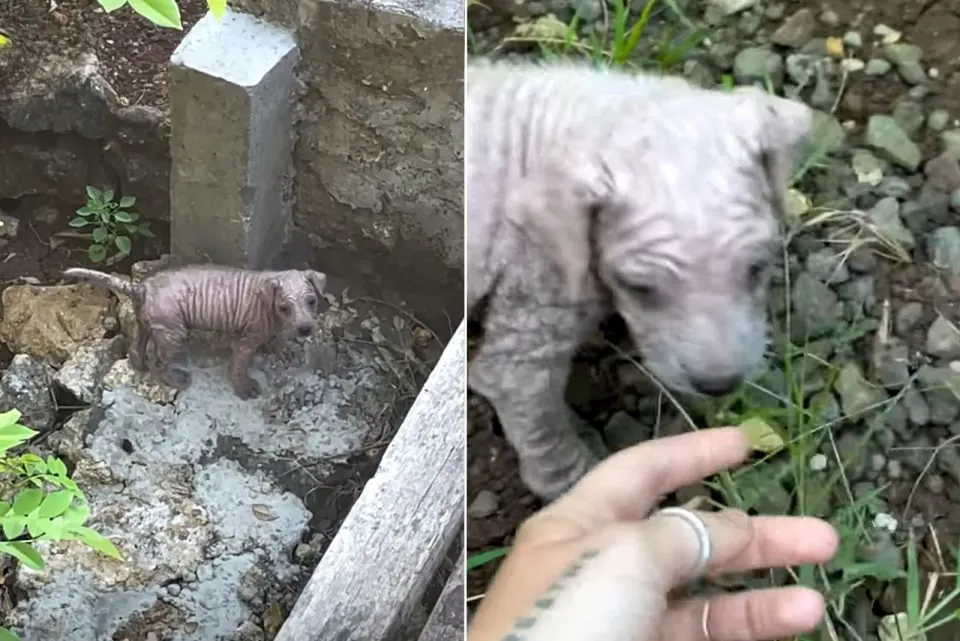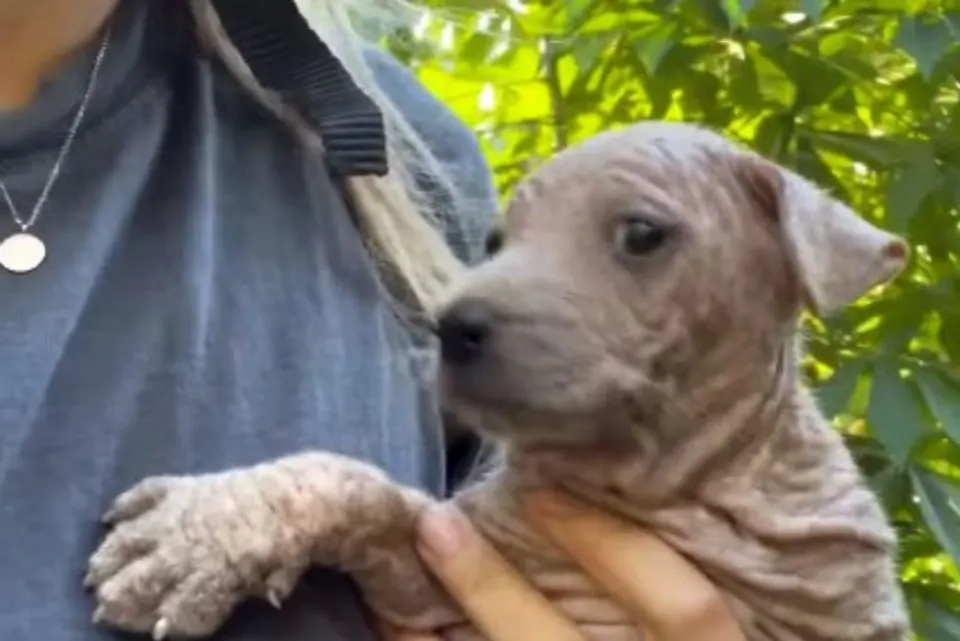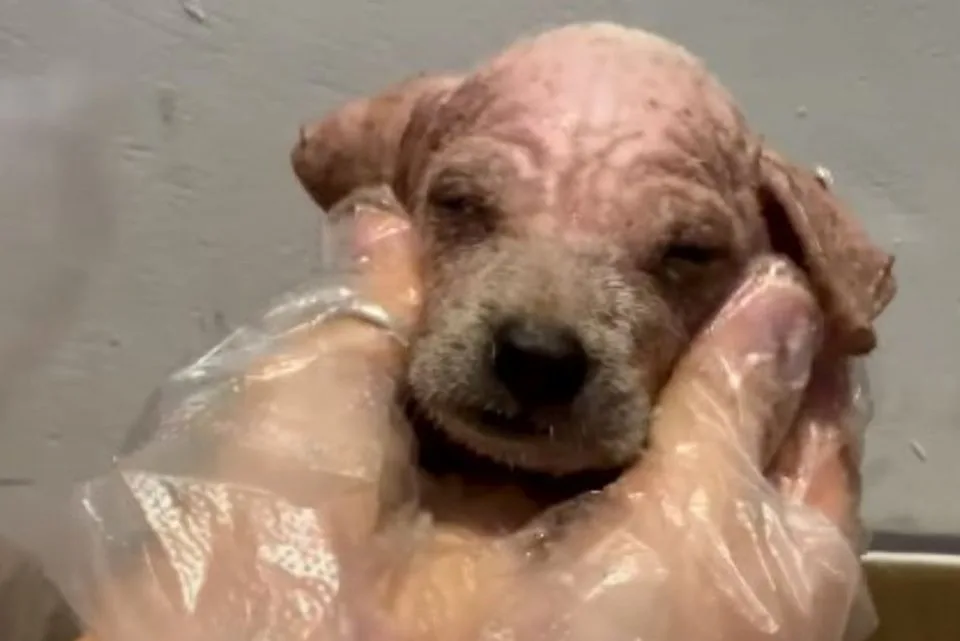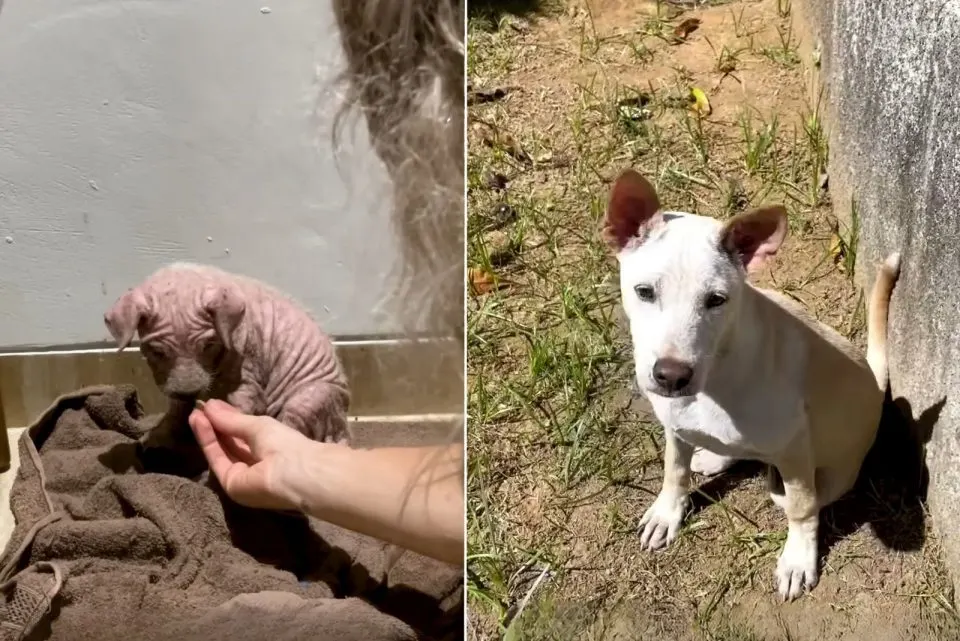Imagine if all of a sudden, you hear crying and yelping sounds coming from somewhere.
What would you do?
If there’s at least one bit of good in you, you would go and investigate those sounds.
If you’re a good human being, then you’d most certainly help.
A woman named Selina heard tiny crying noises and she felt it in her heart that she had to figure out where they were coming from. She felt like someone needed help and she was the one to help them.
But, Selina didn’t expect such a sad surprise…
What’s That In The Riverbed?

Selina’s casual walk was interrupted by some unusual noises.
She had no idea what they were, but she was certain they weren’t coming from a human.
What was it? A cat? A dog?
The only way she could be sure was to follow the noise and see for herself.
The noise led her to a riverbed; fortunately, a dry one.
As the noise got louder, Selina’s eyes locked onto the creature that was producing all the commotion.
It kinda looked like a puppy.
It was shaped like a puppy. It sounded like one, too, but it was lacking certain things.
The poor lost soul was all skin, bones, and wrinkles. The dog in trouble had no coat at all, and it was clear that it was terribly ill.
Selina rushed to save the troubled puppy, climbed up and down the riverbed, and hid the pup snugly in her shopping bag.

But, the day was coming to an end, and no vet in the area was working anymore.
She had no other option than to bring the puppy home with her.
Selina was no expert, but she did her best to ease the pup’s pain. The dog was a sweet little girl, and she was crying in pain all night long. The least Selina could do was massage her with coconut oil to ease her agony.

A miracle happened!
Two days later, the pup was feeling much better and was recovering her strength. She was acting all bouncy and happy. Selina’s magical touch helped her pull through the harshest period of her young life.
And, a month later, the poor pup wasn’t poor anymore. She named her Jenny: a brand new name for a brand new dog.
Jenny got her fur back. There was no trace of the old pup anymore. No one could’ve figured out that Jenny was once in a horrific condition.
The before-and-after photos show an unbelievable transformation!

If Selina hadn’t heard all that screaming, Jenny would be just another dog lost in the wilderness of Bali, Indonesia. This isn’t the first successful rescue behind Selina. She has devoted her life to saving and adopting dogs in Bali.
If you follow her on Instagram, you can see the progress of each rescue operation, and even donate to help her save more pups in need.
As for Jenny, she’s looking for a furever home… someone that would devote their entire time to this happy doggo. Whoever becomes Jenny’s new owner would be thrilled to have such a sweet dog.
If you’ve ever found yourself wondering why your furry friend seems to have a gas-passing habit that could rival a frat boy’s, you’re not alone. Dog farts, while often the source of giggles, can sometimes leave you questioning what’s going on inside your canine companion. It’s like having a little stinker on four legs, right? Understanding the reasons behind your dog’s excessive flatulence can shed light on potential health issues or dietary factors that may need tweaking. So, grab a seat, and let’s sniff out the mystery behind why your pup toots so much.
Understanding Dog Farts: What’s Normal and What’s Not
The Science Behind Canine Digestion
Dogs, like humans, digest their food with the help of enzymes and bacteria in their gastrointestinal tract. When your dog eats, the food travels through the digestive system, where it is broken down and nutrients are absorbed. During this process, gases can build up, leading to farting. It is a natural occurrence as part of digestion.
What Constitutes Excessive Farting in Dogs
Excessive farting in dogs can be a sign of an underlying issue. While occasional gas is normal, if your dog is farting more frequently than usual, it could indicate a problem. Factors such as diet, allergies, gastrointestinal issues, or even swallowing air while eating too quickly can contribute to excessive flatulence. If your dog’s farting is accompanied by other symptoms like diarrhea, vomiting, or changes in appetite, it’s essential to consult your veterinarian to rule out any health concerns.
Common Causes of Frequent Dog Farts
Diet-Related Factors
Your dog’s diet can play a significant role in causing excessive flatulence. Certain foods like beans, dairy products, and fatty foods can be hard for dogs to digest, leading to increased gas production. Additionally, switching your dog’s food suddenly or feeding them table scraps can also result in gassiness. Ensure your furry friend’s diet is well-balanced and suitable for their digestive system to reduce the chances of frequent farting.
Lack of Exercise and Obesity
If your dog doesn’t get enough exercise or is overweight, they may experience more gas than usual. Physical inactivity can slow down digestion, causing food to ferment in the gut and produce excess gas. Ensure your dog gets regular exercise to keep their digestive system healthy and promote proper digestion, which can help lessen farting episodes.
Breed Predispositions and Genetics
Certain dog breeds are more prone to flatulence due to their genetics and physical characteristics. Breeds with short noses, such as Bulldogs and Pugs, tend to swallow more air while eating, leading to increased flatulence. Similarly, smaller breeds may have sensitivities to certain foods that result in excessive gas production. Understanding your dog’s breed tendencies can help you manage and address their farting issues effectively.
Health Concerns Linked to Excessive Farting
Indications of Digestive Troubles
If your dog’s frequent farting is accompanied by other digestive issues like bloating, diarrhea, or vomiting, it could indicate underlying digestive problems that need to be addressed. These signs may suggest issues with food intolerance, gastrointestinal infections, or inflammatory bowel disease. Keep an eye on your dog’s overall digestive health to spot any concerning symptoms early on.
When to Consult Your Vet
While the occasional fart is normal for dogs, excessively smelly gas or persistent flatulence could be a cause for concern. If your dog’s farting is disrupting their daily activities, causing discomfort, or has a sudden change in odor or frequency, it’s best to seek advice from your veterinarian. Your vet can help determine if there are any underlying health issues contributing to your dog’s excessive farting and recommend appropriate treatment options.
How to Reduce Your Dog’s Flatulence
Tweaking Your Dog’s Diet
To reduce your dog’s flatulence, start by tweaking its diet. Avoid giving table scraps or foods high in gas-producing ingredients like soy, dairy, or high-fat content. Opt for high-quality dog food with easily digestible proteins and limited fillers or additives. Additionally, consider feeding smaller, more frequent meals to help with digestion and reduce bloating.
Regular Exercise and Weight Management
Regular exercise is essential in managing your dog’s flatulence. Ensure your furry friend gets enough physical activity to prevent constipation and promote overall gut health. Maintaining a healthy weight through a balanced diet and exercise can also alleviate pressure on the digestive system, reducing the likelihood of excessive gas buildup.
Probiotics and Digestive Supplements
Incorporating probiotics and digestive supplements into your dog’s routine can aid in reducing flatulence and improving gastrointestinal health. Probiotics help balance the gut flora, promoting better digestion and reducing gas production. Digestive enzymes can also be beneficial in breaking down food more efficiently, decreasing the chances of excess gas formation.
By adjusting your dog’s diet, encouraging regular exercise, and incorporating probiotics and digestive supplements, you can effectively manage and reduce your furry companion’s flatulence. Remember, if your dog’s gas issue persists or is accompanied by other symptoms like discomfort or changes in stool consistency, consult with your veterinarian for proper evaluation and treatment.
Conclusion
So there you have it – understanding why your furry friend lets one rip so often can help you tackle their toots head-on. From diet tweaks to more playtime, you’ve got the tools to combat your pup’s excessive gas. Remember, a healthy diet and lifestyle changes can make a real difference in reducing your dog’s farting episodes. And if the fart symphony continues, don’t hesitate to reach out to your vet for some expert advice. Keep those tails wagging and those farts at bay!
Frequently Asked Questions
Q: What are the common factors that contribute to a dog’s excessive flatulence?
A: Factors like diet, allergies, gastrointestinal issues, lack of exercise, and breed predispositions can lead to excessive flatulence in dogs.
Q: How can I reduce my dog’s flatulence?
A: To reduce your dog’s flatulence, you can adjust their diet to avoid gas-producing ingredients, feed smaller meals, promote regular exercise, and consider incorporating probiotics and digestive supplements.
Q: When should I consult a vet regarding my dog’s farting issues?
A: Consult a vet if your dog’s farting persists or is accompanied by discomfort, as it may indicate underlying health issues that require proper treatment.
[no_toc]

Hey there, I’m Janet Brooks, a dog-loving student from California. I’m all about helping pups in need, especially those without homes. Me and my awesome friends work together to give shelter and love to stray dogs. Oh, and I also write blogs about dogs to share helpful info.